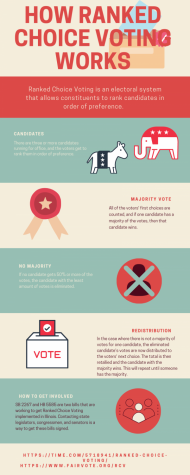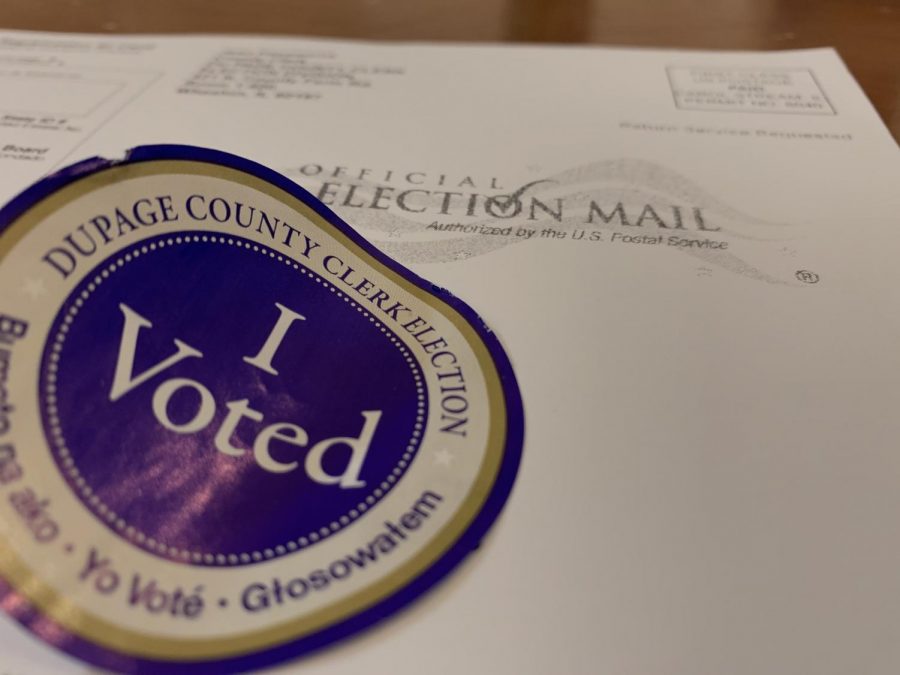Ranked-choice Voting is a new direction for the electoral voting system
Ranked-choice voting is a different method of voting in which candidates are chosen in order of preference.
January 28, 2021
Since the 1700s, the United States has had a voting system built around the idea of democracy. It is a system that gives people of the country the right to make a decision on who will run the country. The practice of democracy and voting in the United States has seen a great number of changes regarding who can vote, how voting works, and what voting means. It has had significant importance in the running of this country. Currently, in most presidential electoral systems, the voter chooses only one person they want to win. However, other countries use a separate system to determine winning candidates called ranked-choice voting. Ranked-choice voting allows constituents to rank the candidates by preference, in numerical order (1 being the candidate they want most, 5 being their least-desired candidate). This means that they can submit a ballot for more than one candidate in the order of whom they prefer.
Ranked-choice voting has the ability to support minority candidates, as well as the ability to give constituents the chance to vote for who they want to rather than who they have to- loosening the grip of powerful political parties. Metea Class of 2020 alumni, Evan Lemberger, is a firm believer in making ranked-choice voting the norm for the United States, but he is starting off smaller in Naperville. After researching and not being able to find many places to volunteer to get ranked-choice voting started in Naperville, he decided to start his own chapter in Naperville. He is currently getting in contact with statewide politicians as well as Citizens of Metea to spread this idea to a younger audience.

“Our representatives oftentimes do not represent us,” Metea Class of 2020 alumni Evan Lemberger said. “There are a lot of people in this country who did not support either of the last two presidents, either in primaries or in the general, and yet they still went on to win their elections. People who are running for office do not need majority support to win. They do not need over 50% of the votes to win and that’s a majority they only need a plurality which is more than everyone else. For some races, this can be as low as 34% of the votes or even 16% of the votes depending on who’s running. And that means that you will have a plurality- more people voted against you than people voted for you. And in my opinion, that’s not an acceptable way to run a democracy.”
Ranked Choice Voting differs in that it favors the majority winner.
“Everybody can relate to voting for somebody that they hate because it’s the only option that they might really have [in order to] go against someone they hate even more,” Lemberger said. “Therefore, you have to compromise on your values to support the lesser of two evils. Ranked-choice voting is the voting method where you
don’t have to do that.”
The only city in Illinois that uses the system in Springfield, and even then, the system is only for military and overseas voters. As of now, cities such as Berkeley, CA, and New York City, NY is using ranked-choice voting to elect specific candidates such as the mayor and city council.
“With ranked-choice voting, we can encourage people who don’t win the plurality but [still] have majority support,” Lemberger said. “Illinois needs this because this country needs this…The more states and cities that are willing to take part in this, the further the ball will roll until this entire country is using it.”
Ranked-choice voting has advantages and disadvantages. This may include misinformation being spread around that makes it harder for people to understand what it is. Because ranked-choice voting is limited to only a few cities and states, the way it works is not often taught in an educational setting.
“The biggest disadvantage with it is when people don’t understand how it works. It makes their votes less powerful in the system,” Lemberger said. “When certain people aren’t educated about this properly, they’ll only rank one person. If they get eliminated, their vote won’t count. That could be okay if you don’t want to rank everybody, that’s your choice just like it’s your choice not to vote, but some people don’t understand that that’s what they’re doing. And it’s important that education initiatives teach them what that means.”
Naperville currently does not have ranked-choice voting, but there are some pushing for a vote in 2022 in which Naperville residents will have the opportunity to vote for whether or not they would like to have this system implemented. Naperville can decide their own election procedures as well as Aurora because they are home-rule cities, meaning there are local solutions presented for local issues.
“I’m currently talking to a lot of my politicians to try to get some legislation passed for rank choice voting in Naperville,” Lemberger said. “The way that this works is that we need the city council and the mayor to approve a ballot referendum, so, in the year 2022, Naperville citizens will be able to vote. We cannot do this without public education on ranked-choice Voting, because we need people to understand how it works. That also involves a team of people to help me do this. If you want to support ranked-choice Voting, you can call your state legislators, senators, and congressmen about two bills: SB 2267, and HB 5585. If either of those passed, we will have statewide ranked-choice Voting for offices such as the governor.”
Those who are interested in taking part in Lemberger’s efforts can contact [email protected].
Correction: The version we originally published included a typo in Evan Lemberger’s contact. The story has been updated to the correct email address and we apologize for the confusion that was caused.









other voting systems • Jan 28, 2021 at 11:11 pm
This website https://ncase.me/ballot/ has a really cool simulation of other voting systems, like score voting. Um… but this is still pretty cool. The author argues for score voting because the spoiler effect can still happen with ranked-choice, but I certainly agree that loser’s votes should not just be discarded as they are in FPTP.